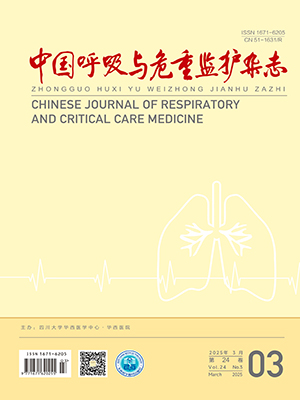| 1. |
Huang KW, Yang T, Xu JY, et al. Prevalence, risk factors, and management of asthma in China: a national cross-sectional study. Lancet, 2019, 394(10196): 407-418.
|
| 2. |
Bateman ED, Boushey HA, Bousquet J, et al. Can guideline-defined asthma control be achieved? The Gaining Optimal Asthma ControL study. Am J Respir Crit Care Med, 2004, 170(8): 836-844.
|
| 3. |
Nathan RA , Thompson PJ, Price D, et al. Taking Aim at Asthma Around the World: Global Results of the Asthma Insight and Management Survey in the Asia-Pacific Region, Latin America, Europe, Canada, and the United States. J Allergy Clin Immunol Pract, 2015, 3(5): 734-742. e5.
|
| 4. |
林江涛, 王文巧, 周新, 等. 我国十城市支气管哮喘控制和疾病管理及患者认知水平的变化. 中华结核和呼吸杂志, 2018, 41(3): 191-195.
|
| 5. |
包海荣, 杨洁, 郭超, 等. 甘肃省不同级别医院哮喘患者的控制现状及对疾病认知程度的基线调查. 中国呼吸与危重监护杂志, 2013, 12(5): 446-450.
|
| 6. |
谢华, 陈萍, 张志远, 等. 施行规范化管理10年单中心住院支气管哮喘患者调查结果分析. 中华结核和呼吸杂志, 2019, 42(3): 179-184.
|
| 7. |
Janson C, Menzies-Gow A, Nan C, et al. SABINA: an overview of short-acting β2-agonist use in asthma in European countries. Adv Ther, 2020, 37(3): 1124-1135.
|
| 8. |
周新. 将中国支气管哮喘防治指南推广普及到基层. 中华结核和呼吸杂志, 2018, 41(3): 161-162.
|
| 9. |
刘春涛. 我国西部地区支气管哮喘防治的瓶颈和对策. 中华结核和呼吸杂志, 2018, 41(3): 2.
|
| 10. |
Shelley M , Croft P, Chapman S, et al. Is the quality of asthma prescribing, as measured by the general practice ratio of corticosteroid to bronchodilator, associated with asthma morbidity? J Clin Epidemiol, 2000, 53(12): 1217-1221.
|
| 11. |
中华医学会呼吸病学分会哮喘学组. 支气管哮喘防治指南(2020年版). 中华结核和呼吸杂志, 2020, 43(12): 1023-1048.
|
| 12. |
Corrao G, Arfè A, Nicotra F, et al. Persistence with inhaled corticosteroids reduces the risk of exacerbation among adults with asthma: a real-world investigation. Respirology, 2016, 21(6): 1034-1040.
|
| 13. |
Bateman ED , Price DB, Wang HC, et al. Short-acting β2-agonist prescriptions are associated with poor clinical outcomes of asthma: the multi-country, cross-sectional SABINA III study. Eur Respir J, 2022, 59(5): 2101402.
|
| 14. |
Wang CY, Lai CC, Wang YH, et al. The prevalence and outcome of short-acting β2-agonists overuse in asthma patients in Taiwan. NPJ Prim Care Respir Med, 2021, 31(1): 19.
|
| 15. |
Bloom CI, Saglani S, Feary J, et al. Changing prevalence of current asthma and inhaled corticosteroid treatment in the UK: population-based cohort 2006-2016. Eur Respir J, 2019, 53(4): 1802130.
|
| 16. |
Choi JY, Yoon HK, Lee JH, et al. Nationwide use of inhaled corticosteroids by South Korean asthma patients: an examination of the Health Insurance Review and Service database. J Thorac Dis, 2018, 10(9): 5405-5413.
|
| 17. |
Suruki RY , Daugherty JB , Boudiaf N , et al. The frequency of asthma exacerbations and healthcare utilization in patients with asthma from the UK and USA. BMC Pulm Med, 2017, 17(1): 74.
|
| 18. |
Bleecker ER, Menzies-Gow AN, Price DB, et al. Systematic literature review of systemic corticosteroid use for asthma management. Am J Respir Crit Care Med, 2020, 201(3): 276-293.
|




